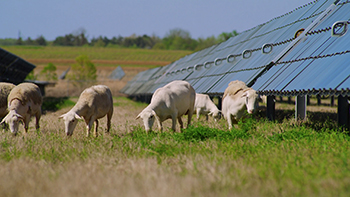Land occupied by solar farm being used for agricultural production
BLAKLEY, Ga. – A solar farm that Walton Electric Membership Corporation (EMC) depends on to provide electricity to Facebook’s Newton Data Center is now a farm in every sense of the word.
When Facebook decided to build its Newton Data Center, the social media giant chose Walton EMC as the power supplier. One of the deciding factors in picking the co-op is that it could meet Facebook’s desire for 100 percent renewable energy to power the facility.
Walton EMC then partnered with Silicon Ranch, one of the largest independent solar power producers in the country, to build and deliver some of that renewable energy. Their resulting 1,200-acre solar farm is located in Early County, which is primarily an agricultural community.
It turns out that those 1,200 acres are producing more than solar electricity.
 |
Sheep grazing at a Silicon Ranch solar farm, similar to the one Walton EMC relies on to power Facebook’s Newton Data Center, are helping to improve the soil, air, water and economy. Silicon Ranch’s Regenerative Energy platform delivers the maximum environmental benefits from its solar facilities. |
Once solar panels are installed on a tract of land, the land underneath typically goes idle. It’s usually mowed, but any agricultural production or cultivation ceases.
Silicon Ranch has changed that. Their Early County site is the first new build to incorporate the company’s holistic Regenerative Energy™ platform.
To deliver Regenerative Energy, Silicon Ranch partners with renowned regenerative ranchers and farmers who deploy holistic farming practices on the solar farm. The solar farm then provides forage for grazing animals, pollinator habitat (for honeybees and the like) and wildlife environment.
The grazing animals, like cattle and sheep, return their wastes to the soil, building valuable organic matter. The farmers that partner with Silicon Ranch also plant cover crops and refrain from tilling the soil.
By controlling the timing, intensity and frequency of grazing to mimic the natural relationship between native grasslands and large herds of grazing animals, the Regenerative Energy process improves soil health and increases the cycling of nutrients, carbon, water and energy.
In contrast, traditional farming methods, like using synthetic fertilizer and heavy tillage, deplete the soil’s organic matter.
Besides enabling the production of a marketable agricultural commodity on the solar farm, Regenerative Energy provides many other benefits, including:
- Improved soil
- Improved air and water quality
- Increased diversity in animal and plant life
- Trapping carbon in the soil
- Job creation
- Stronger rural economies
The program is verified by independent, trusted third-party entities and certified.
“We’re proud to partner with such a forward-thinking company,” said Walton EMC CEO Ronnie Lee. “Silicon Ranch, through their Regenerative Energy program, is extracting the maximum environmental benefits from their solar development. They’re delivering much more than renewable energy.”
“We at Silicon Ranch are excited to pioneer this holistic program that generates clean energy, healthy soil and food, and jobs for farmers in Georgia, said Reagan Farr, President and CEO of Silicon Ranch Corporation. “As the long-term owner and operator of every project in our portfolio, we are committed to continuously exploring new opportunities to be better stewards of our land and better citizens in the communities we serve.”
Walton EMC is a customer-owned power company that serves 130,000 accounts over its 10-county service area between Atlanta and Athens. Besides delivering reliable electric service, the company places a priority on improving the communities it serves. Learn more about the cooperative at facebook.com/waltonemc.
Silicon Ranch is the U.S. solar platform for Shell and one of the largest independent solar power producers in the country. Silicon Ranch develops to own all of its projects for the long-term, a distinction that means the company is deeply committed to its partners and communities and stands behind the performance of its facilities day-in and day-out. The company’s operating portfolio includes more than 120 facilities across 14 states from New York to California, including the first large-scale solar projects in Georgia, Tennessee, Arkansas and Mississippi. To learn more, please visit siliconranch.com, facebook.com/siliconranch and twitter.com/SiliconRanchCo.
# # #